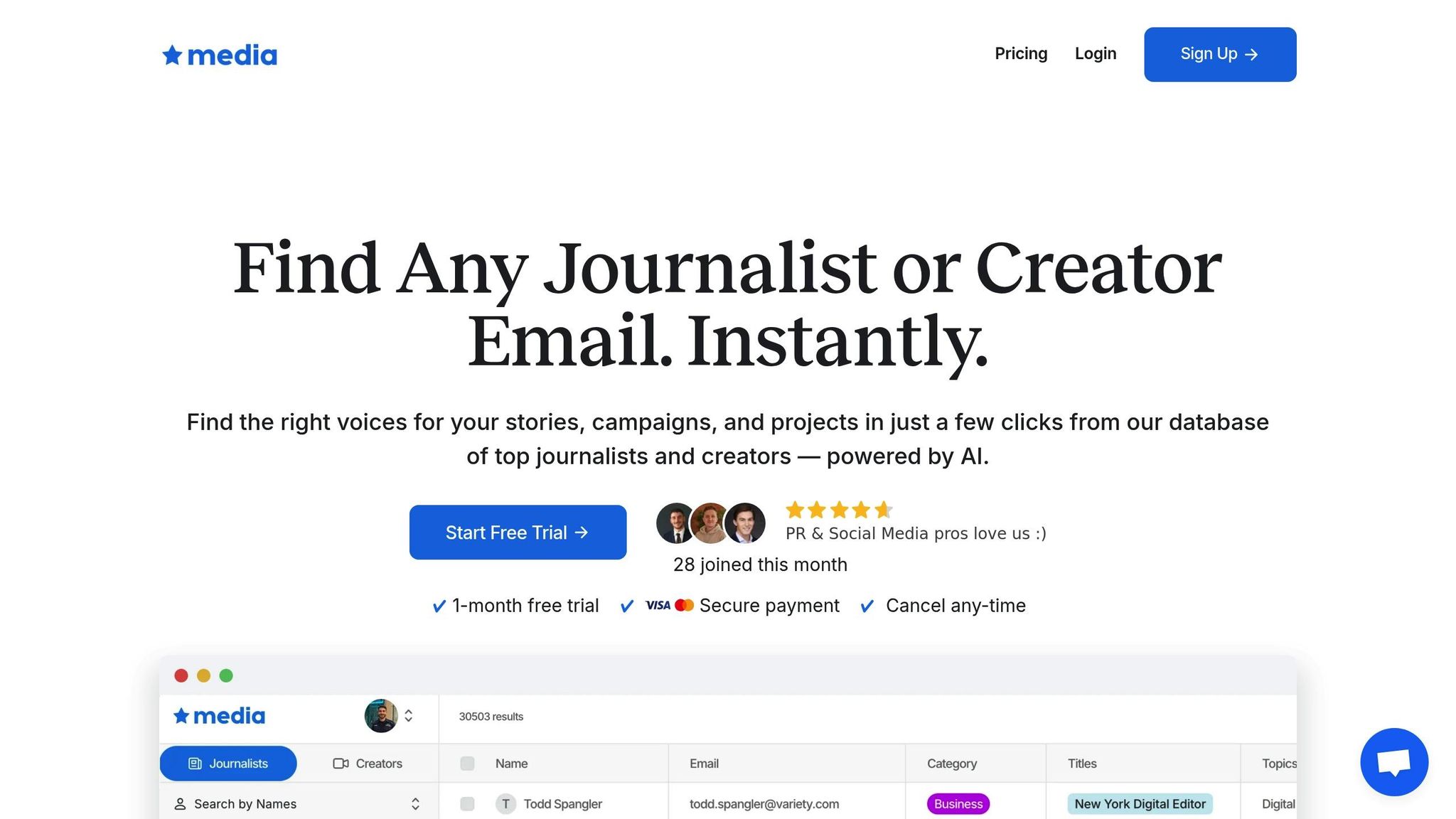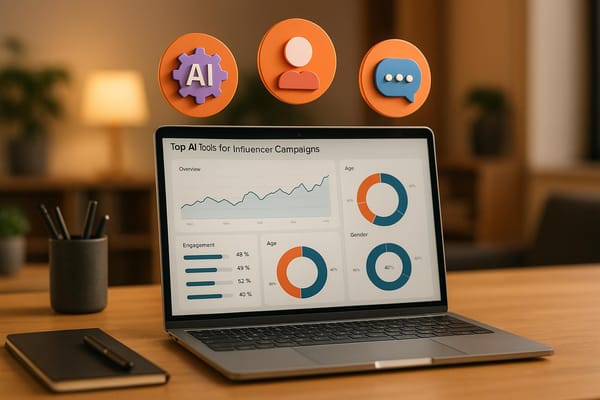Cross-Platform Metrics: What PR Teams Need to Know
Learn how to effectively measure and optimize PR campaigns across multiple platforms for improved insights and better decision-making.

Cross-platform metrics are the key to understanding how your PR campaigns perform across different channels. Instead of analyzing platforms in isolation, these metrics connect the dots - showing how social media, press releases, and websites interact to drive results.
Why does this matter?
- Unified insights: Avoid fragmented data and get a full picture of your campaign's success.
- Better decisions: Allocate resources to what works best, like earned media driving more conversions than social posts.
- Improved ROI: Justify budgets with metrics that show integrated campaign results.
To succeed, you need:
- Clear goals tied to specific KPIs (e.g., reach for awareness, conversions for sales).
- Tools that consolidate data, offer real-time reporting, and provide actionable insights.
- Regular reviews to refine strategies and improve over time.
How To Measure Your Metrics Across Platforms - Social Media Minute
Setting Goals and KPIs for Cross-Platform Campaigns
To measure the success of your cross-platform campaigns, you need to connect each metric to a specific goal. Every campaign objective should directly shape the KPIs you track across platforms.
The idea is simple: tie your business goals to measurable results. For instance, if you're introducing a new product, your main aim might be to generate awareness among your target audience. On the other hand, during a crisis, your focus would shift to monitoring public sentiment and ensuring your message is consistent and controlled.
Define what success looks like for your campaign. Is it driving more traffic to your website? Attracting qualified leads? Enhancing brand sentiment? Or perhaps securing more media coverage? Once you’ve nailed down the definition of success, work backward to identify the metrics that will reveal whether you're on the right path. This approach ensures your objectives align with the metrics that matter most.
Matching Campaign Goals with Metrics
Each campaign goal calls for a unique set of metrics. For awareness campaigns, you might track total reach, earned media impressions, social mentions, and branded search volume. If engagement is your focus, metrics like comment rates, share ratios, click-through rates, and time spent on content will give you insights into how well your message resonates. For conversions, monitor referral traffic from each platform, lead generation by source, conversion rates across channels, and revenue attribution to connect your efforts to tangible outcomes.
It’s also crucial to consider the customer journey when setting KPIs. A potential customer might first learn about your brand through a news article, then follow you on social media, and eventually visit your website. Your metrics should reflect this entire journey rather than isolating performance on just one platform.
Adjusting KPIs for Different Platform Behaviors
Once you’ve established your campaign KPIs, adapt them to fit the specific engagement patterns of each platform.
On LinkedIn, focus on metrics like post engagement, profile views, and connection requests. For Twitter, prioritize retweets, replies, and hashtag performance while ensuring quick response times. On Instagram, track saves, story completions, and user-generated content to gauge how your audience interacts with your brand.
When it comes to traditional media coverage, the KPIs shift. Look at factors such as the publication’s reach (national vs. local), the influence of the journalist, message pull-through rates, and sentiment analysis. A single feature in a major outlet can carry far more weight than dozens of mentions on social media.
Finally, adjust your benchmarks to account for platform-specific behaviors and timing. Social media metrics often spike within hours, while the impact of media coverage might unfold over weeks. By factoring in these timing differences, you’ll ensure your KPI framework accurately evaluates performance on each platform.
Tools for Tracking Cross-Platform Metrics
To manage campaigns effectively, PR teams need analytics tools that bring together data from multiple channels. Without such tools, they often face the chaos of juggling spreadsheets or, worse, miss out on crucial insights that could elevate their strategies.
The right tools offer a unified view by integrating data from various sources, making it easier to track performance and uncover trends across platforms.
Key Features of Cross-Platform Analytics Tools
When selecting a tool, focus on features that streamline your workflow and provide actionable insights:
- Unified dashboards: Look for tools that combine data from social media, websites, email campaigns, and traditional media into a single, easy-to-navigate interface. This eliminates the hassle of switching between platforms and ensures you don’t overlook key patterns or correlations.
- Real-time reporting: For PR teams handling live campaigns, immediate insights are non-negotiable. Tools with hourly updates let you monitor how a story is performing across platforms like Twitter, LinkedIn, and news outlets, enabling quick pivots or responses when needed.
- Seamless integrations: Choose tools that connect with major platforms like social media APIs, Google Analytics, and email systems. Some tools even support webhooks, allowing you to pull data from custom or internal sources.
- AI-driven insights: Advanced analytics tools now use AI to spot trends and patterns that might escape human detection. These features can uncover sentiment shifts, highlight trending topics, and recommend optimal posting times based on past engagement data.
- Customizable reporting: Different stakeholders often need different views of the data. Tools with customizable reporting allow you to tailor insights for your audience - whether it’s high-level brand sentiment for executives or detailed engagement metrics for campaign managers.
- Data export options: For deeper dives or integration with other business systems, ensure the tool supports exporting data in formats like CSV, Excel, or PDF. API compatibility with CRMs or marketing platforms is another plus.
With these features in place, PR teams can create more focused and impactful campaigns.
Using Media AI for PR Campaign Tracking

Once you’ve established a solid analytics framework, tools like Media AI can help fine-tune your outreach efforts, directly influencing the metrics you’re tracking. Media AI’s extensive database of over 30,000 journalists and creators simplifies the process of building targeted media lists, ensuring your content reaches the right audience.
Its advanced filtering capabilities allow you to zero in on contacts most likely to engage with your content, increasing the chances of securing meaningful coverage. This targeted approach not only boosts engagement but also improves the quality of mentions across platforms.
Media AI’s export functionality integrates seamlessly with most analytics tools. You can export detailed media lists, complete with contact information and beat classifications, and use them to create custom tracking segments. This makes it easier to identify which journalists or creators drive the most engagement for your campaigns.
Keeping your outreach efforts relevant is another strength of Media AI. The platform’s regularly updated contact information ensures you’re not wasting time on inactive accounts or outdated details, which could hurt your engagement numbers.
For teams looking to scale their efforts without breaking the bank, Media AI offers a flexible pricing model: $99/month for individual databases or $149/month for full access. This allows you to adjust your tracking and outreach efforts to fit your campaign’s scope and needs.
Common Cross-Platform Measurement Problems and Solutions
When it comes to unified analytics, PR teams face a series of challenges that can derail even the most well-planned measurement efforts. These obstacles, if left unchecked, can lead to missed opportunities and misguided strategies. The good news? Understanding these common issues and having actionable solutions can make all the difference between campaigns that deliver clear, measurable results and those that leave you guessing.
Fixing Data Fragmentation and Inconsistent Metrics
One of the biggest hurdles is data fragmentation - when campaign data is scattered across different platforms, each with its own way of measuring success. For instance, what one platform considers "engagement" might not match how another defines it. This creates a messy, disjointed picture that's hard to interpret.
To tackle this, start by creating a unified measurement framework. Define key metrics consistently across all platforms. For example, decide whether "engagement" includes only likes and shares, or if it also accounts for comments, saves, and click-throughs. Document these definitions and ensure everyone on your team is on the same page.
Another key step is using conversion factors to bridge gaps between platforms. Since similar metrics are often calculated differently, it's essential to identify these discrepancies and adjust your analysis. A simple conversion chart can make it easier to standardize data before combining it.
Automated tools can also simplify data consolidation. Many analytics platforms now offer APIs that pull data directly from social networks, news monitoring services, and email systems. These tools help reduce manual errors and keep your data up to date.
Additionally, consider using standardized reporting templates. Instead of creating separate reports for each platform, develop dashboards that align all your data under a single framework, using consistent terminology and calculations.
Regular data audits are another must. Schedule monthly reviews to compare metrics across platforms and spot any irregularities. For instance, if engagement suddenly spikes on one platform but stays steady elsewhere, it could signal a change in how that platform calculates its metrics.
Of course, having too much data can be just as problematic as fragmented data.
Preventing Data Overload
Tracking an overwhelming number of metrics often leads to "analysis paralysis", where the sheer volume of information makes it difficult to focus on what really matters.
The solution? Focus on three to five core KPIs that align directly with your campaign goals. For example, if your objective is brand awareness, prioritize metrics like reach, share of voice, and sentiment. On the other hand, if you're aiming to drive website traffic, focus on click-through rates, referral traffic, and conversion rates instead of follower counts.
Use supporting data to provide context for your core metrics. For instance, if media mentions are your primary metric for a product launch, journalist engagement rates can help explain the results.
To streamline your workflow, set up alerts for key indicators so you can avoid daily data reviews. This way, you'll only need to intervene when something requires immediate attention.
Time management is also critical. Limit metric reviews to 30 minutes weekly for quick updates and two hours monthly for deeper dives into strategy. This ensures you stay focused on the most important insights without getting bogged down.
Assigning ownership of metrics by role can also help. For example, a social media specialist might handle engagement metrics, while a media relations manager focuses on coverage quality and journalist relationships. This division of labor prevents overlap and ensures every metric gets the attention it deserves.
Finally, use progressive disclosure in your dashboards. Start with high-level summaries that show overall campaign performance, and let team members drill down into specific platforms or time periods as needed. This approach keeps dashboards clean and ensures everyone has access to the right level of detail for their role without overwhelming them with unnecessary information.
Using Metrics to Improve PR Strategies
Once you’ve established a solid data framework, the next step is turning those metrics into actionable strategies for PR. Cross-platform metrics aren’t just numbers - they’re a guide to making smarter decisions. The challenge lies in interpreting the signals your data provides and using those insights to refine your approach as you go.
Reading Data for Campaign Optimization
Metrics should guide your PR team’s decisions, helping you spot patterns and make timely adjustments to your campaigns.
Refining your message often starts with sentiment analysis. For example, if your LinkedIn content is receiving positive engagement but your Twitter discussions lean negative, it’s worth analyzing why the tone shifts between platforms. Adjust your messaging to ensure it resonates with each platform’s unique audience.
Prioritizing channels and allocating resources becomes easier when you compare engagement rates and cost-per-engagement across platforms. A channel with high impressions but low engagement might not be connecting with your audience. If Instagram Stories consistently outperform Facebook posts with the same effort, it’s a clear signal to shift resources toward Instagram.
Optimizing timing is another area where data shines. By studying engagement patterns, you might find that one platform performs best on weekday mornings, while another peaks in the evenings. Use these insights to schedule posts for maximum impact instead of posting at random.
Choosing the right influencers and journalists is more effective when you look beyond follower counts. Focus on metrics like click-through rates, time spent on content, and conversions. A journalist with a smaller but highly engaged audience might generate better outcomes than one with a broader but less active following.
Deciding on content formats should also be data-driven. If videos consistently outperform static images, or long-form articles drive more website traffic, adjust your content mix accordingly. Let the numbers guide where you invest your creative efforts.
Incorporate these insights into regular performance reviews to keep your strategy sharp and responsive.
Regular Review and Improvement Process
Once you’ve made data-driven adjustments, set up a structured review process to maintain and enhance your campaigns. Regular reviews ensure you’re always improving.
Weekly pulse checks are for quick, tactical reviews. Spend 15–20 minutes examining core KPIs to catch any sudden shifts. If a piece of content is performing exceptionally well, amplify it. If something isn’t resonating, pivot quickly.
Monthly deep dives focus on strategic analysis. Look for trends, recurring audience behaviors, and connections between metrics. For instance, an increase in media mentions might correlate with a delayed rise in website traffic, hinting at a broader attribution window than you originally thought.
Quarterly strategy reviews take a big-picture approach. Assess whether your cross-platform efforts align with your overall business goals and whether shifts in audience behavior require major adjustments. This is also a good time to evaluate if your measurement framework needs updating.
Campaign post-mortems are invaluable for learning. After a major campaign, analyze what worked and what didn’t across all platforms. Document successful tactics, note surprises, and pinpoint areas for improvement. These lessons will guide future campaigns.
Updating benchmarks is essential as your PR efforts evolve. What once seemed like strong performance might become your new baseline. Regularly revisiting benchmarks ensures you’re always aiming higher.
Sharing knowledge with your team prevents insights from being siloed. Create short monthly summaries of key takeaways and share them with everyone. If one team member discovers that certain hashtags boost engagement or specific story angles resonate better with journalists, the entire team benefits.
The goal isn’t about achieving perfection - it’s about continuous improvement. Each review cycle should uncover at least one actionable insight to make your next campaign stronger. Whether it’s tweaking your content calendar, refining your media list, or reallocating your budget, small, consistent changes can add up to a significant competitive edge over time.
Conclusion: Cross-Platform Metrics for PR Success
In today's competitive landscape, cross-platform metrics aren't just a bonus for PR teams - they're absolutely essential. Research shows that campaigns spanning multiple platforms can increase brand recall by 20% and boost conversion rates by 25%. That’s a game-changer for demonstrating the true impact of your PR efforts.
To make this work, everything starts with a solid foundation: clear goals, the right tools, and actionable insights. This means sticking to consistent UTM conventions, using standardized tracking, and integrating systems that feed all your data into one central dashboard. Without these basics, even the most advanced analytics tools won’t give you the reliable insights you need to succeed.
Tools like Media AI simplify the process by providing access to a database of 30,000 journalists and creators, complete with advanced filtering and export capabilities. When you connect your outreach data to your overall analytics setup, you gain a complete view of how media coverage drives engagement and conversions.
But having the tools isn’t enough - you have to use them effectively. Top-performing PR teams regularly review their analytics to fine-tune their strategies.
And the rewards? They’re massive. Advertisers who nail cross-platform campaigns see a 35% higher ROI and a 50% increase in click-through rates when they leverage multiple channels with precision targeting.
Your cross-platform metrics strategy should grow alongside your PR efforts. Start small - track a few channels - and gradually build toward sophisticated attribution models that show exactly how each touchpoint contributes to your success. By integrating these evolving strategies with a unified measurement framework and consistent review processes, you’ll create a winning formula for optimizing your campaigns and maximizing your impact.
FAQs
How can PR teams set the right KPIs to align with their cross-platform campaigns?
To establish effective KPIs, PR teams need to begin by setting clear, measurable objectives that align with their campaign goals. A great way to do this is by applying the SMART framework: ensure your objectives are specific, measurable, achievable, relevant, and time-bound. Once these goals are defined, use historical data to create practical benchmarks and set realistic, platform-specific targets that resonate with your audience and strategy.
Keep your focus on key metrics that directly reflect your campaign’s impact. Metrics like media impressions, share of voice, engagement rates, and conversions can provide valuable insights into performance. Regularly track these KPIs and be ready to tweak your approach to stay aligned with your goals. This ongoing evaluation helps ensure your KPIs remain meaningful and actionable throughout the campaign.
For teams aiming to simplify their workflow, tools like Media AI can be a game-changer. These tools make it easier to identify influential journalists and creators, giving your campaigns a boost with data-driven insights for better results.
What are the best practices for selecting and using analytics tools to track cross-platform metrics?
To keep track of cross-platform metrics effectively, PR teams should opt for analytics tools that offer a centralized dashboard. This allows you to view real-time data from multiple platforms in one place, making it easier to uncover insights and act on them without wasting time. Look for tools that integrate smoothly with your current workflows and provide customizable reports, so you can zero in on the metrics that truly matter.
Equally important is setting up a flexible tracking framework that can adapt as your campaigns grow and change. Make it a habit to regularly check your data for accuracy and relevance, tweaking your strategy as needed. Tools like Media AI can help simplify this process by combining powerful analytics with an extensive database of journalists and creators. This not only makes outreach more efficient but also supports smarter, data-driven decisions for your PR efforts.
How can PR teams avoid fragmented data and ensure consistent metrics across platforms?
To keep data cohesive and ensure reliable metrics, PR teams should rely on a centralized platform or dashboard that brings all measurement tools together. This setup allows key metrics to be tracked and analyzed in one place, cutting down on inconsistencies and saving valuable time.
In addition, conducting regular system audits and using AI-powered tools can improve data accuracy and simplify workflows. These tools can automate data integration, highlight inconsistencies, and deliver actionable insights - freeing up PR teams to concentrate on strategy instead of getting bogged down with manual data tasks.





